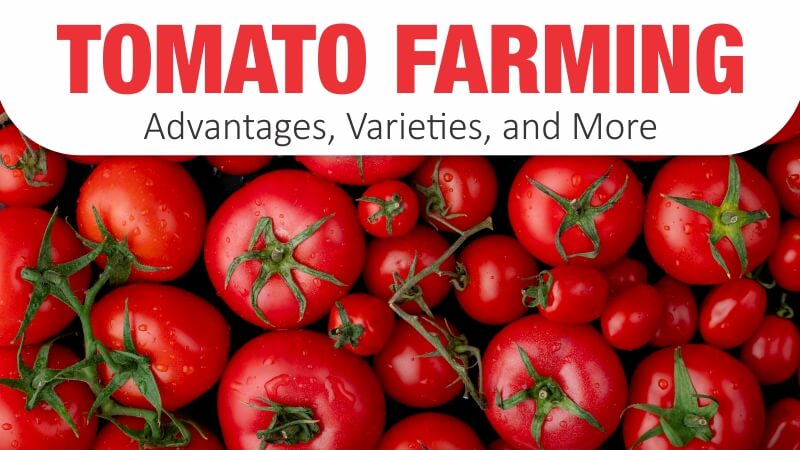In India, tomatoes are a significant commercial vegetable crop. Every Indian meal is incomplete without tomato. Because they are an abundant source of vitamins A, C, potassium, and minerals, tomatoes are in high demand all year long. It can be used raw or cooked, or even added to sauces, jams, soups, juices, and other dishes. Thus, growing tomatoes can be a lucrative business and even guarantee significant earnings. This KhetiGuru Blog will give you all detailed information on how to launch a tomato farming business and also assist you in considering the benefits of the industry.
The advantages of growing your own tomatoes are numerous. Compared to tomatoes from the grocery store, they are tastier and contain higher levels of antioxidants. Additionally, there are tens of thousands of tomato types available to you, all with unique forms, sizes, colors, and flavor profiles that you won’t find in any supermarket. Tomatoes are a simple food to produce, and they may even be grown indoors under grow lights without the need for a yard, in containers on a patio or balcony. When it comes to storage and preservation, tomatoes have more possibilities than other crops. If you still have unripe green tomatoes at the end of the season, you can pick them or cook them.
Advantages of Tomato Farming:
- Growing tomatoes has a number of benefits, but their rapid growth rate is one of the most important. As a result, they guarantee that farmers spend less time working and make more money.
- Because they may be grown both indoors and outdoors, tomatoes are quite flexible.
- The harvests are often higher and can offer strong financial returns if you closely adhere to the soil and water requirements.
- Because of their high vitamin and antioxidant content, tomatoes are always in demand.
- One of the main nations that export tomatoes are India. As a result, farmers have a great opportunity to boost their income by exporting to other nations.
Climatic Conditions For Tomato Farming:
Tomatoes are said to thrive best in a warm but temperate environment with some sunlight. Since tomatoes are sensitive to unfavorable environmental circumstances, such as frost or humidity, they grow best in the temperature range of 10 to 25°C. Farmers must provide various climatic circumstances during each stage of the plant’s growth, germination, blooming, and fruiting for high-quality crops.
Soil Requirements:
The majority of soil types, from light sand to thick clay, are suitable for growing tomatoes. But the best option would be sandy soil that drains effectively and has a high organic content at a depth of 15-20 cm. Tomatoes don’t need a lot of organic matter in the soil, in contrast to most crops. This is so that tomatoes can’t resist naturally high moisture found in soil with high organic content. However, farmers can boost output by incorporating organic matter into soil that is mineral-rich. Although tomatoes can thrive in soil that is only mildly acidic and saline, it is nevertheless vital to measure the pH of the soil before planting tomatoes. Maintaining a range of 7-8,5 will guarantee healthy growth.
Season and Land Preparation For Tomato Farming:
Any season can be used to cultivate tomatoes. However, transplantation differs regionally. Tomatoes are transplanted in the south in three cycles: from December to January, from June to July, or from September to October. Transients in the northern region In the northern region, transplantation takes place in February, October to November, and July (during the Rabi crop cycle) (Zaid season).
Level soil is necessary for tomato production. For thorough tillage and levelling, plough the ground four to five times. For higher harvests, add manure or organic fertilizers when you last ploughed the field. To get rid of pests and bacteria that spread disease, the soil needs to be properly sterilized via soil solarization.
Five Renowned Tomato Varieties Uses, and Health Advantages:
Tomatoes are frequently red but can also be yellow, orange, or purple. They have a pleasant, fresh flavor. They are rich in antioxidants like beta carotene and lycopene, as well as vitamins C and E, which have a number of positive health effects. Although there are thousands of varieties of tomatoes, many of which are hybrids, they can be divided into six groups. Since they are all fruits of the Solanum Lycopersicum plant, tomatoes are frequently referred to and prepared as vegetables in cooking.
- Cherry Tomatoes:
Cherry tomatoes are small, oblong, and so juicy that they might burst when you bite into them. One cherry tomato contains only three calories and minute amounts of numerous vitamins and minerals (17 grams). They are the ideal size for salads or to eat on their own as a snack.
- Grape Tomatoes
Cherry tomatoes are bigger than grape tomatoes. They don’t have as much water and are oblong. A single calorie can be found in an 8 g grape tomato. Like cherry tomatoes, grape tomatoes taste well in salads or as a snack. They would probably be insufficient to use as skewers as well. The grape variety can be a better choice if the juiciness of cherry tomatoes turns you off to them.
- Roma Tomatoes
Roma tomatoes are bigger than cherry and grape tomatoes, but they are still too little to be cut into slices. Romas is sometimes known as plum tomatoes. The 11 calories and 1 gram of fiber in a 62-gram Roma tomato. They are perfect for preserving or making sauces because they are naturally sweet and juicy. They are frequently used in salads.
- Beefsteak Tomatoes
Beefsteak tomatoes are a fantastic option because they are big, strong, and hard enough to maintain their shape when thinly sliced. Having a 3-inch (8-cm) diameter, a large (182-gram) beefsteak tomato offers 33 calories, 2 grams of fiber, and 28 percent of the Daily Value for the immune-supporting antioxidant vitamin C.
They are perfect for preserving or preparing sauce because of their moderate flavor and juicy texture.
- Green Tomatoes
Green tomatoes come in two varieties: heirlooms, which become red when fully ripe, and unripened, which are still green. Certain regions cook with green tomatoes that aren’t ripe. For instance, fried green tomatoes are well-liked in the Southeastern United States. As with other varieties, green tomatoes are hard, simple to slice, and low in calories, with only 28 calories in one medium (123-gram) green tomato.
They work well for both sauce preparation and canning. They are acidic and slightly sour, which gives meals a distinctive flavor and color.
For Tractor related information and to know more about farm equipment and machinery visit the KhetiGaadi website.




